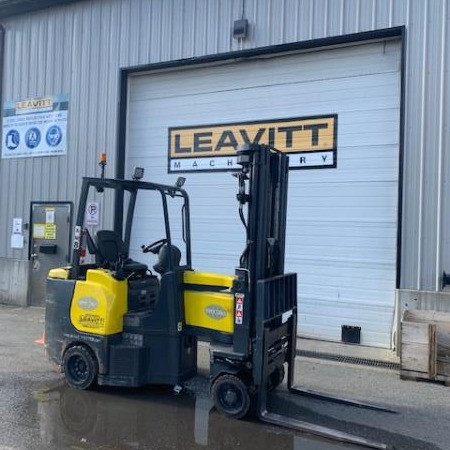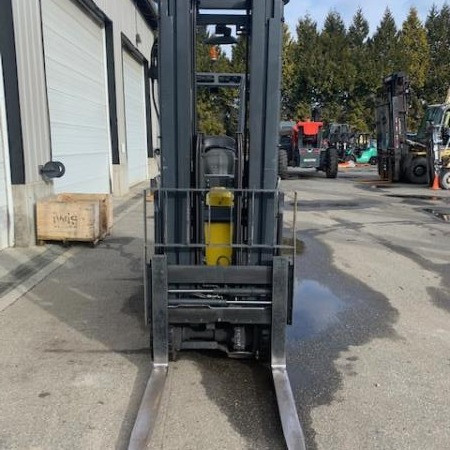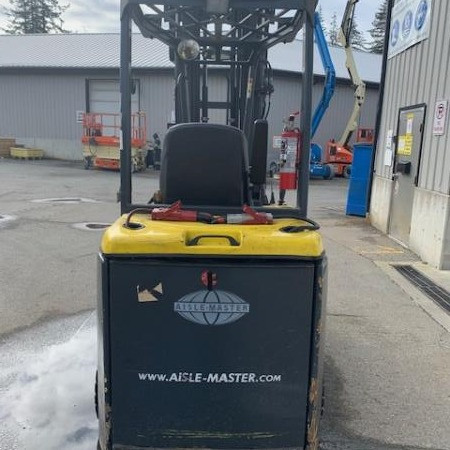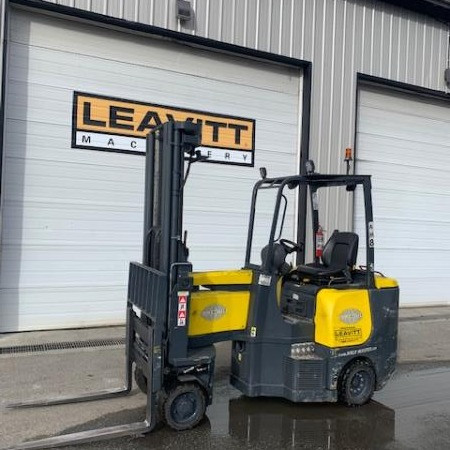Very Narrow Aisle Forklift Long Beach
Used Very Narrow Aisle Forklift Long Beach - Warehousing solutions often focus on layout and space saving solutions in order to cut down on costly square footage and decrease travel time required to transport goods throughout the warehouse and loading dock areas. Extremely narrow aisles offer more storage space since there is less space needed for aisle access. Warehouse optimization consists of warehouse configurations.
Warehouse Optimization
Several benefits can be enjoyed for adding very narrow aisle warehouse optimization such as more storage space for the facility.
Using narrow forklift trucks instead of traditional forklifts can enable the warehouse width of the aisles can be lessened to half. Certain models of very narrow aisle forklifts can increase the square foot storage capabilities by delivering greater stacking heights. Very narrow aisle forklifts can greatly reduce costs compared to traditional forklifts since the same amount of stock takes up less space in the warehouse. In most urban areas where square footage is very costly, this is a huge benefit to warehouse operations. Warehouse storage can be increased up to eighty percent with careful planning when a narrow aisle width configuration is utilized. Very narrow aisle design facilitates greater product access and more rack faces. Since greater quantities of products are situated in a more accessible area, there is less travel time needed for gathering and storing items.
It is common for warehouses to use a very narrow or narrow aisle layout. Narrow aisles are measured as those that use fewer than eleven feet of aisle width. Very narrow aisles usually use an aisle width of approximately 6.5 feet across. Both of these aisle widths provide significantly increased storage opportunities. Standard forklifts can have issues with turning in these aisle widths. A variety of very narrow forklifts have been designed to easily maneuver in narrow aisles.
When selecting a forklift for a job application, it is essential to know the aisle dimensions. Having the right aisle dimensions will save money and time instead of purchasing the wrong forklift that won’t be able to conquer the applications. Taking note of any utilities, columns or posts is necessary before choosing a particular narrow aisle forklift design to maximize warehouse optimization and safety.
Very Narrow Aisle Forklift Trucks
As these units are mostly powered by electricity, rechargeable batteries are popular for very narrow aisle forklifts. These very narrow aisle trucks are more commonly available as stand-up riders, which helps increase productivity and operator comfort. There are different very narrow aisle forklift designs such as order pickers, reach trucks, wing-mast or turret and end-control riders.
Reach Forklift Trucks
The reach trucks were created as a type of rider stacker forklift but can be modified specifically for narrow aisle usage. This machine earned its name by its ability to reach its forks to secure a load. The moving mast and the moving carriage are two types of reach trucks. The moving carriage works by raising and lowering the carriage, along with the operator. While the operator stays at ground level, the moving mast is responsible for raising and lowering the forks. Of the two kinds of reach trucks, the moving mast reach truck is the safer of the two varieties. Reach trucks use a pantograph system, a type of jointed framework, which allows the operator to reach for or place a load without the need to move the forklift itself.
Order Pickers
Order pickers have been designed and developed specifically for use in picking orders from high, typically hard-to-reach racks. These machines are used for picking up lighter stock that can be moved by hand. They lift the operator up to reach the goods by identifying and choosing certain items to create an order.
End-Control Riders
End-control riders are machines that pick loads up at floor level and move the items horizontally as opposed to lowering or lifting over numerous heights.
Turret or Swing-Mast Forklift
The turret or swing mast very narrow aisle forklifts have a swivel mast that pivots and articulates. Pallets can be set on either the right or left side of the forklift due to the machine’s ability to use its’ swinging mast.
Guided Very Narrow Aisle Trucks
Very narrow aisle forklift trucks can be guided by rail or wire down the aisles.
Because the forklift is guided, thereby reducing the possibility of the forklift bumping racks while moving down the aisle, the aisles can be extremely narrow. For rail-guided systems, a series of rails are installed into the floor, on both sides of the aisle, and run along the floor for the length of the aisle, curving around the end of the aisle. Specific wheel guides are on the forklift. These slide into the rails to stop the forklift from moving out of the rail guards.
Running down the center of the aisle, wire-guidance forklifts rely on floor wires instead of rails. These wire-guides work along the same principle as the rail guards except that the narrow aisle forklift is fitted with a wire-guide system that allows it to communicate with the floor wires which effectively steer the forklift, preventing it from straying outside of an allotted range.
Work Site Considerations
Certain essential considerations need to be dealt with before using a narrow aisle configuration. The narrow aisle units feature tall racking systems. The floor construction and the racks need to be carefully taken into account for everyone’s safety. There are four areas which must be meticulously prepared before setting up a racking system and must be continuously monitored and maintained throughout the operation of the warehousing system:
1. The floor must be level;
2. Cracks must be repaired;
3. Load capacity of floor must be appropriate; and
4. The racks must be plumb.
Level Floor
Due to the racking system height, any minor floor slope can gravely impact how plumb the racks are, particularly over time if loads are placed and removed repeatedly on the racks. The height of the racking system means that any minute floor slope can have a negative impact on how straight the racks are, especially over time when loads are continually removed and placed on the racks. Without a level floor foundation, the rack stability could be compromised.
Crack Repair
When cracks in the floor are spotted, they should be assessed and, when necessary, repaired immediately. Safety can become compromised when flooring cracks become 3/8 inches wide. They require proper filling with a substance that is as hard as the floor.
Floor Load Capacity
The floor should meet certain minimum requirements before considering a narrow aisle configuration. The floor should have three thousand psi concrete minimum and contain evenly distributed rebar at three to four inches under the surface. Depending on the load requirements and configuration, additional reinforcements may be needed.
Plumb Racks
Of great importance is the proper installation of the racking system. Rack failure can happen if they are improperly installed. All racks need to be plumb and this is one of the most vital aspects of correct installation. If necessary, rack shims should be used to ensure the racks are plumb within 1 inch at the 30 foot height of the racks.
Racking failure can happen if the aforementioned measures are not taken or implemented correctly. Racking failure can kill or injure employees, damage equipment and result in horrible damage. These measurements are vital to the success of installing a safe and productive narrow aisle configuration.
Very Narrow Aisle Forklift PDF
Stock Number: 209213 GL
Make: AISLEMASTER
Model: 44SE
Year: 2015
Price: $15,500
| Stock Number |
209213 GL |
| Make |
AISLEMASTER |
| Model |
44SE |
| Year |
2015 |
| Category |
Very Narrow Aisle Forklift |
Stock Number: 207213 GL
Make: AISLEMASTER
Model: 44E
Year: 2013
Price: $21,000
| Stock Number |
207213 GL |
| Make |
AISLEMASTER |
| Model |
44E |
| Year |
2013 |
| Category |
Very Narrow Aisle Forklift |
Stock Number: 208758 GL
Make: AISLEMASTER
Model: 44SE
Year: 2015
Price: $20,500
| Stock Number |
208758 GL |
| Make |
AISLEMASTER |
| Model |
44SE |
| Year |
2015 |
| Category |
Very Narrow Aisle Forklift |













